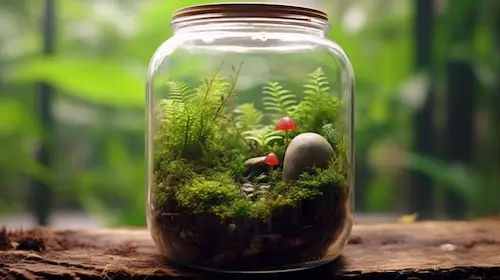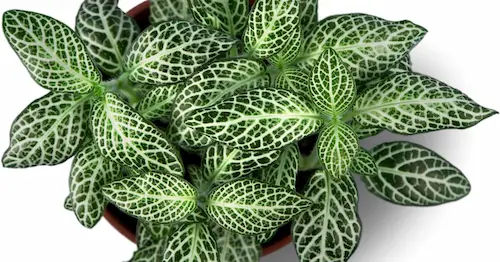Understanding Terrarium Plants

Last week we talked about the perks of building a terrarium. While building one is easy, knowing which plant to make with may not be. So today, we will delve into one of the specifics of terrarium building, namely, introduce the various types of plants commonly found in a terrarium. So the next time you build your terrarium, you can make an informed decision.
1. Fittonia

There is no plant more fitting for the top of the list than the Fittonia Nerve plant. The plant is also known as the mosaic plant, having roots in the South America rainforest. The plant is a tropical species, getting an all year round green allure, coupled with beautiful veins that contrast with the olive green, such as silver white and pink. Not all Fittonia have the same colour scheme, but they all look distinctively elegant with the secondary coloured veins. Moreover, the plant thrives in a terrarium setting. It detests direct sunlight instead preferring the fluorescent light and also needing little water to sustain itself. In a non-terrarium setting, this plant could be a piece of work to handle, which is why it is a match made in heaven for the terrarium. It is no surprise that the Fittonia plant is fit to be first on this list.
2. Succulent

Next up on the list are the succulents. As the word succulent implies, these plants have parts that are thick and juicy, capable of holding liquid in them to ensure survival in the arid climate. This unique quality, along with their differentiated appearance, makes their kind suitable for living in a terrarium – To look attractive and not be needy (water), kind of like what we are looking for in our partners too. Some of the famous succulents we are probably acquainted with already are Aloe Vera and the subgroup of cacti. Do note that a sealed terrarium will not be good for the succulent.
3. Carnivorous

If I had to pick one plant for my very own terrarium, I would pick the Venus Fly Trap. It’s like keeping a pet demon in my room whose favourite snack happens to be Singaporean’s greatest enemy, the annoying Mosquitoes. With fang-like jaws ready to be unleashed, it is a badass looking terrarium. A point to note, while the plant can survive without insect food for a month or two, if it fails to find its prey, someone has to feed it a live one somehow. Still, this is no reason to stop from having a mosquito rattrap. If the fangs are not your preferred weapons of choice, there is also the pitcher plant with its bottomless pit and the Butterworts with its sticky trap. The arsenal is plentiful to choose from.
4. Peperomia

While the Peperomia species look luscious, there is no distinct characteristic on the outside, like that of the cacti or Fittonia species. Though generally, they do have thick stout stems and fleshy leaves. These can often be used in combination with ferns for the best aesthetic look. They are generally easy to maintain which makes them ideal for a terrarium. Do share your thoughts on which terrarium plant you plan on doing and any tips that you may want to add.
Frequently Asked Questions
If you have any questions about the Understanding Terrarium Plants, you can refer to the frequently asked questions (FAQs) about the Understanding Terrarium Plants below:
What is a terrarium?
A terrarium is a miniature indoor garden enclosed within a transparent container, such as a glass jar or vase. It typically contains small plants, soil, and decorative elements, creating a self-contained ecosystem that requires minimal maintenance.
What types of plants are suitable for terrariums?
Several types of plants are suitable for terrariums, including succulents, ferns, mosses, air plants (Tillandsia), and small leafy plants like fittonia or baby tears (Soleirolia soleirolii). It’s essential to choose plants that thrive in the relatively humid and low-light conditions typically found in terrariums.
How do I care for plants in a terrarium?
Caring for plants in a terrarium involves providing the right amount of light, water, and ventilation to maintain a healthy environment. Place the terrarium in indirect sunlight or under artificial grow lights, as direct sunlight can cause excessive heat and damage the plants. Water the plants sparingly, as the enclosed environment retains moisture, and overwatering can lead to root rot. Prune and remove dead or yellowing leaves as needed to maintain the appearance of the terrarium.
Can I use any type of soil in a terrarium?
The type of soil used in a terrarium depends on the types of plants being grown and the desired drainage and moisture retention properties. A well-draining potting mix formulated for indoor plants is typically recommended for terrariums. Some gardeners prefer to use a mixture of potting soil, perlite, and sand or charcoal to improve drainage and aeration in the soil. Avoid using soil from the garden, as it may contain pests, pathogens, or excess nutrients that can harm the plants in a terrarium.
How do I design and arrange plants in a terrarium?
Designing and arranging plants in a terrarium involves considering factors such as plant size, shape, and growth habit, as well as aesthetic preferences and functional considerations. Start by selecting a focal point plant or centerpiece and then add complementary plants around it, considering their growth requirements and visual appeal. Experiment with different arrangements and compositions until you achieve the desired look and balance in your terrarium.
